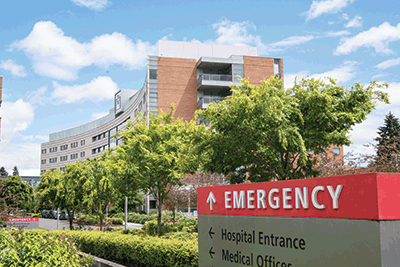While the increase in residents with some sort of health insurance has been welcome, the reality is that Medicaid provides only 40 cents of reimbursement to doctors and hospitals for every $1 of care provided.
The negative financial impact on providers is significant and not limited just to the surge of Medicaid patients, said Tim Strickland, spokesman for PeaceHealth, the Vancouver-based not-for-profit regional health care system.
For example, PeaceHealth Southwest Hospital in Vancouver has seen a jump in Medicaid patients coming to its emergency department this year, but also more non-Medicaid ER patients who have private insurance but with high-deductibles.
These patients can’t pay the deductible, so the hospital must decide whether to write-off that debt as charity, he said. ?“The financial impact of all this is significant and not limited to the Medicaid situation,” he said. “The community needs to know that we are committed to working with our fellow healthcare providers to find a sustainable solution that works for Medicaid patients while also securing the long-term viability of our respective healthcare missions,’ he said.
Strickland would not elaborate on how that collaboration might proceed.
Vancouver Clinic changes
Last month, The Vancouver Clinic, with 190 physicians working at eight locations, announced that as of July 1 it will no longer accept new Medicaid patients because of the related financial burden. In addition, over the next few years, the clinic hopes to reduce its Medicaid patient population from a current 25 percent to about 10 percent.
In a prepared statement, Clinic Administrator Duane Lucas-Roberts said, “…historically low reimbursement rates for serving Medicaid patients have made it increasingly difficult to provide quality care to all our patients in a way that is financially sustainable.”
Lucas-Roberts also called for a community-wide solution to the Medicaid problem.
“We hope to work with other local partners to search for a community-wide solution so that all Medicaid patients in Clark County receive the care they need and deserve,” he said.
Meanwhile, five primary-care doctors working at Hudson’s Bay Medical Group in Vancouver have nowhere to refer their low-income patients who often need follow-up specialty care for chronic problems related to diabetes, heart conditions or back trouble, said Frances Langan, Hudson’s Bay administrator.
“With the Vancouver Clinic closing its doors to new Medicaid patients we have no where to send them,” Langan said. “Some say it’s a doctor shortage, but I see it as a reimbursement shortage problem. Medicaid reimbursement rates hardly pay for our receptionist.”
The reimbursement issue already has forced Hudson’s Bay to reduce operating costs by cutting staff.
Legacy sees Medicaid surge
Brian Willoughby, spokesman for Legacy Salmon Creek Medical Center in Vancouver, said the hospital emergency department has also seen an increase of new Medicaid patients.
“Starting last Oct. 1, Legacy began accepting Kaiser Permanente patients, which increased our overall patient totals,” Willoughby said. “We’d budgeted for about 165 people a day in the emergency department. This month (June) we’re averaging 197 a day. The Kaiser volume added a bunch, but that doesn’t account for everything.”
Overall, the hospital saw a 3.4 percent bump in Medicaid patients from January through March of this year. In 2013, Medicaid patients accounted for 18.1 percent of the total patient volume; in the first three months of this year, that volume rose to nearly 21.5 percent.
“Everyone is watching carefully to see how this all goes,” Willoughby said. “The jury is still out on the long-term changes coming out of the Affordable Care Act. It’s a big ship to turn.”
Free clinic adjustments
Early this year, the Free Clinic of Southwest Washington saw a 35 percent decline in patient visits because more low-income Vancouver-area residents qualified for Medicaid and sought care elsewhere.
Now the clinic, which operates urgent walk-in medical and dental clinics with a 600-member volunteer staff including 125 health care professionals, is seeing a return of Medicaid patients who cannot find a doctor, said Barbara West, clinic administrator.
“We also are seeing people with insurance but with high co-pays who can’t swing it,” West said. “We changed our policy so we can serve these under-insured people who can’t get care (because they can’t afford the co-pay or the high-deductible).”
To manage the changes, West reduced the free clinic budget in the coming fiscal year from $1 million to $850,000.
“It was the toughest budget I’ve ever written … we’ve cut staff.”
Looking ahead, West said the region’s healthcare system faces “enormous new challenges.”
“We’ve gone through step one to get these people insured, but we didn’t think about whether they would be able to access care once they were insured. We set people up to expect care. But with federal reimbursement rates for Medicaid and Medicare not going up even as the number of people in those two categories increases, how do we manage the cost of care? This requires a redesign of the healthcare delivery system,” she said.
PeaceHealth’s Tim Strickland said that Clark County and Southwest Washington are not alone in facing the latest round of challenges.
“What’s happening here is no different than what’s happening all around the country,” he said. “There’s not a national solution so we have to work together to find a local solution.”
Nationally, Medicaid enrollment is expected to annually increase 2 to 3 percent through 2024. According to a report in the Wall Street Journal, many will remain uninsured because they earn more than the maximum poverty levels to qualify for Medicaid, but will not be able to afford insurance purchased through insurance exchanges and will opt to pay penalties instead.
{jathumbnail off}




